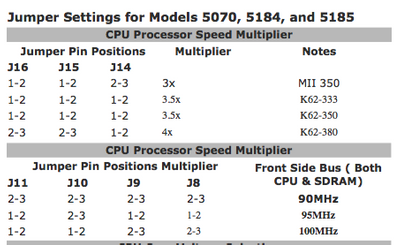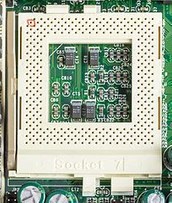First post, by TOMMY_THE_DOG
- Rank
- Newbie
Hello everyone. I have a Compaq 5184 mini-tower with a SS7 motherboard and a K6-2 CPU. The system shipped with a 380MHz CPU, which I decided to upgrade to a 533MHz. Both regular K6-2s with the same rated voltages. The faster CPU went into the socket just fine, and the system boots and runs well. But the new CPU was running at the same 380MHz as the stock CPU! As reported by the BIOS and CPU-Z. The BIOS will not allow me to change the multipliers, but I found some spotty documentation that showed me where the jumpers are on the motherboard for changing CPU and FSB multipliers. I was able to bump the FSB up to 100MHz, which brought the CPU to an even 400MHz speed. Somehow this modest speed increase was quite noticeable in Win98SE. But it is still far below this processor's rated speed. The system runs very stable at this configuration.
The documentation only mentions clock multipliers up to 4x for the CPU. The jumpers on the motherboard were already set to that. I experimented with all of the different combinations of jumper positions, but the only other one that POSTed was the setting that brought the CPU to 266 MHz.
Is there any way to set the CPU multiplier in software? What program would I need? Is there any work around at all? A new BIOS to flash? This is a SiS530 chipset. I know that it is not a highly regarded chipset, but I am very happy with this system for the most part. I just want it to be a bit faster.


